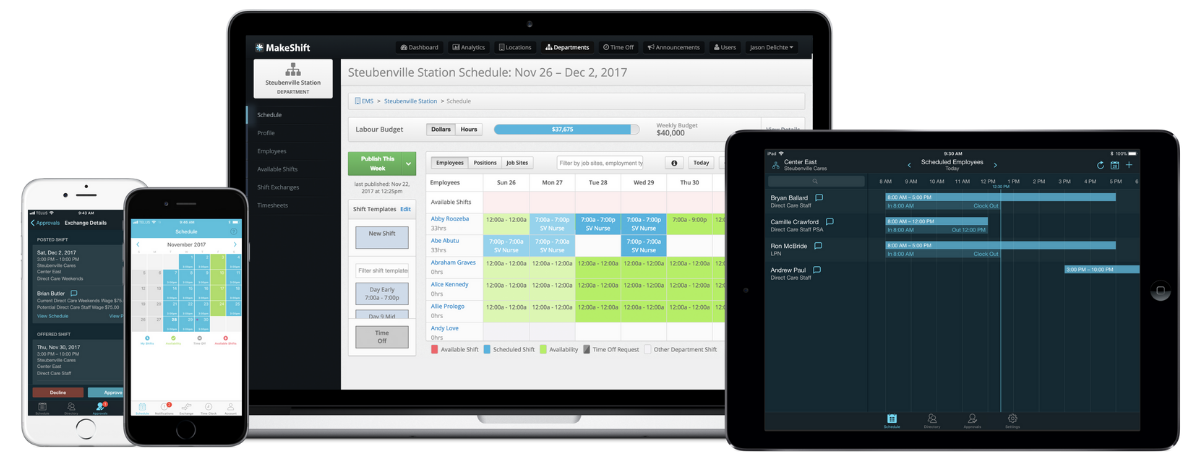Picture this — a world where nurses have a say in their work schedules.
It's not a pipe dream…it's a self-scheduling system, and it’s becoming more prevalent on the daily.
This practice has been around since the 60s, but with today’s tech, it’s more streamlined and user-friendly.
Self-scheduling gives nurses the power to choose their shifts and take charge of their work-life balance.
In a post-pandemic era where priorities have shifted, it's time to explore how nurse self-scheduling can revolutionize your facility and improve the employee experience by a mile.
Today, we’ll dive into the perks and concerns and give you a roadmap to successful implementation.
- 5 Benefits of Nurse Self-Scheduling
- 4 Common Concerns When Considering Switching to Self-Scheduling for Nurses
- How to Implement Self-Scheduling with Your Nursing Staff
- MakeShift supports nurse self-scheduling
- The Future of Nurse Scheduling
- FAQ
What is Nurse Self-Scheduling?
Nurse self-scheduling isn’t new. Hospitals first experimented with it in the 1960s. Since then, many hospitals have started successful self-scheduling systems.

Photo Credit: Harold Barkley/Getty Images
Self-scheduling lets nurses choose their shifts. Instead of shouldering all shift planning and schedule creation yourself, you give your nurses the option to pick shifts that best suit their personal needs.
A self-scheduling system enhances employee experience, improves work-life balance, and streamlines your scheduling process. It also addresses the shift in many employees’ post-Covid priorities.
According to Gartner, 65% of employees say the pandemic made them rethink the place work should have in their lives. After Covid’s squeeze on healthcare workers, it’s no wonder nurses’ priorities have changed regarding their work life.

5 Benefits of Nurse Self-Scheduling
Nurse self-scheduling goes beyond just improving the scheduling process — it profoundly impacts nurse well-being, patient care, and healthcare organization efficiency.
A self-scheduling system offers a wide range of advantages for both nursing staff and healthcare organizations. Here are 5 core benefits:
1. Enhanced Nurse Well-Being
A nurse self-scheduling system empowers nurses to choose shifts that align with their personal lives, allowing for a better balance between work and family commitments. This flexibility can reduce stress and burnout.
In addition, nurses can better manage their work hours, preventing excessive overtime and fatigue. The result? Well-rested nurses who are more alert and provide safer patient care.
Nurses with a say in their schedules develop a sense of autonomy and control, resulting in higher job satisfaction and engagement.
2. Optimized Staffing and Patient Care
Self-scheduling software often includes demand forecasting and real-time data analysis features. This ensures adequate staffing levels, minimizing over or understaffing during different shifts.
Adequate staffing resulting from self-scheduling leads to more consistent, safe nurse-to-patient ratios. Nurses can provide more focused and efficient care when sufficient staff members are available.
Self-scheduling lets nurses choose shifts that match their expertise and familiarity with specific patients or units, promoting continuity of care.
3. Cost-efficiency and Resource Optimization
Self-scheduling helps manage labor costs by minimizing the need for costly overtime or agency staff during staffing shortages.
A growing shortage of nurses is attributed to nurses fleeing the industry and retiring nurses, outpacing new entrants into the field. Worldwide, 1.1 million nurses are needed to address the current nursing shortage.

By aligning staffing levels with demand, self-scheduling ensures resources are allocated efficiently, reducing wastage and improving budget management.
4. Improved Staff Retention
Offering self-scheduling as a perk can help you attract and retain top nursing talent. It demonstrates a commitment to staff well-being and work-life balance.
Because nurses who have more control over their schedules are less likely to jump ship, reducing turnover rates. This stability benefits both nurses and your organization.
5. Streamlined Administrative Processes
Self-scheduling software automates many scheduling tasks, reducing the administrative burden on nurse managers and HR staff.
Nurses can access their schedules and make changes digitally, leading to less back and forth between them and management to manage the schedule.
4 Common Concerns When Considering Switching to Self-Scheduling for Nurses
Any new system comes with concerns, no matter how life-changing it may be. Being prepared for the challenges you might face when implementing self-scheduling will help you put to rest any staff concerns.
1. Employee Resistance
Some nurses may resist self-scheduling due to fear of unfair workload distribution or preferences. For example, a newer nurse may be concerned that others will consistently get to choose the desirable shifts, leaving them with a schedule full of leftover shifts no one else wants.
You can address this concern by creating a solid self-scheduling policy with guidelines for equity and fairness.
Nurses already have a full plate and may worry about the added responsibility and accountability of managing their own schedule.
Adopting staff scheduling software with a mobile app can put their mind at ease, knowing they can manage their schedule right on their phone.
2. Scheduling Errors and Confusion
Some of your team members may worry about scheduling mistakes, which could result in staffing shortages.
Others might be concerned about managing shift swaps or finding replacements when unexpected conflicts arise.
You can put these concerns to rest by using scheduling software that alerts you when the schedule doesn’t jive with your set rules. The software should also make shift swaps a breeze through their mobile app.
4. Impact on Patient Care
A hospital administrator may be concerned that self-scheduling might prioritize individual preferences over patient needs.
Again, this is where a good scheduling policy comes into play. In addition, prioritize clear communication and collaboration among your nursing staff to ensure adequate coverage.
5. Administrative Challenges
RN managers could be concerned about the increased administrative burden of a self-scheduling system.
They could also worry about ensuring compliance with labor laws, union agreements, and organizational policies.
Any nursing staff scheduling software worth its salt will allow you to set compliance guideline rules and should decrease administrative burden, not add to it.
Now that you’re prepped to handle concerns, let’s talk about how to set up a self-scheduling system for your nurses.
How to Implement Self-Scheduling with Your Nursing Staff
“It's important to have a sound idea, but the really important thing is the implementation.” — Wilbur Ross
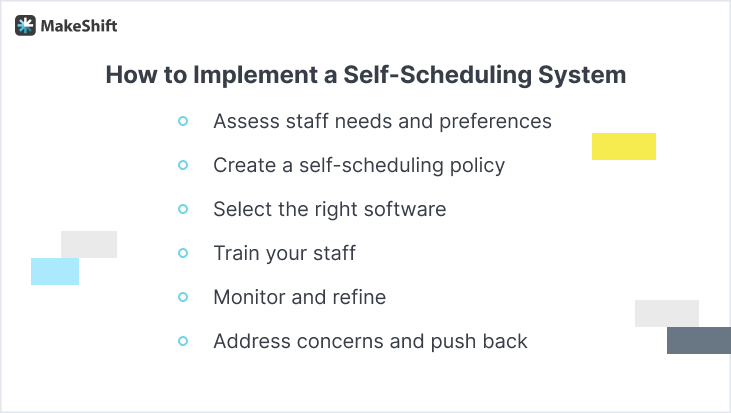
Self-scheduling can revolutionize your nurse scheduling system, but how impactful it is depends on your implementation.
Follow these 6 steps to set your organization up for scheduling success.
1. Assess the Needs and Preferences of Your Nursing Staff
Before you do anything else, find out what’s important to your nursing staff.
- Conduct surveys or focus groups to understand your nurses' scheduling preferences.
- Identify specific needs, like part-time or full-time schedules, day or night shifts, and desired days off.
- Consider other factors like commute times and childcare responsibilities when assessing individual preferences.
2. Create Your Self-Scheduling Policy
You need a solid, well-thought-out policy to head off concerns and address common scheduling issues to ensure your self-scheduling system works well for everyone.
- Determine group rotation — Your nursing staff can actively determine group rotation schedules based on their preferences, expertise, and availability to develop a fair and efficient rotation system that suits their needs.
- Introduce the scheduling process — Encourage nurses to engage in the scheduling process by offering input on patient care demands and staffing needs, fostering a collaborative approach that considers their insights.
- Set scheduling requirements — If using scheduling software, have your nurses set their availability, including preferred shift lengths and days off.
- Time off request rules — Nurses should have access to a user-friendly system for requesting time off, enabling them to submit requests while adhering to facility policies easily.
- OT Policy — Get your nurses involved in shaping your overtime policy, establishing guidelines prioritizing their well-being and minimizing excessive overtime hours.
- Compliance tracking — Bring in nurses to help with compliance tracking efforts. This ensures schedules align with labor laws, rest hour regulations, and contractual agreements.
3. Select the right self-scheduling software
It’s essential to do thorough research and choose self-scheduling software that aligns with the unique requirements of YOUR nursing staff.
Prioritize features like:
- User-friendly interfaces
- Mobile access
- Shift trading capabilities
- Customization options.
Don’t forget to confirm integration compatibility with your existing HR and payroll systems for seamless management.
4. Training and onboarding staff on the new system
Provide comprehensive training sessions for all nursing staff to familiarize them with the self-scheduling software. Then, offer ongoing support through tutorials, FAQs, and a dedicated point of contact for questions or issues.
Encourage your team to explore the software and practice self-scheduling to build confidence.
Practice patience, it takes time for everyone to get the hang of a new system.
5. Monitor and refine the scheduling process
Establish KPIs to measure the success of your self-scheduling implementation and continuously gather nurse feedback to identify areas of improvement.
Regularly review scheduling data and adjust the process to address any challenges or changing needs.
6. Address concerns and push back
Hold open forums or meetings to address nurses' concerns and listen to their feedback.
Communicate the benefits of self-scheduling, like increased autonomy and more work-life balance.
Also, offer support to resistant nurses by highlighting the advantages and addressing misconceptions.
How MakeShift Supports Nurse Self-Scheduling
MakeShift was developed to put people first in the scheduling process. We created each feature to minimize time-consuming tasks for RN managers and nursing staff while encouraging team communication.
We offer intuitive, interactive scheduling to simplify self-scheduling for your nursing staff and you.
Nurses can easily set and manage their availability.
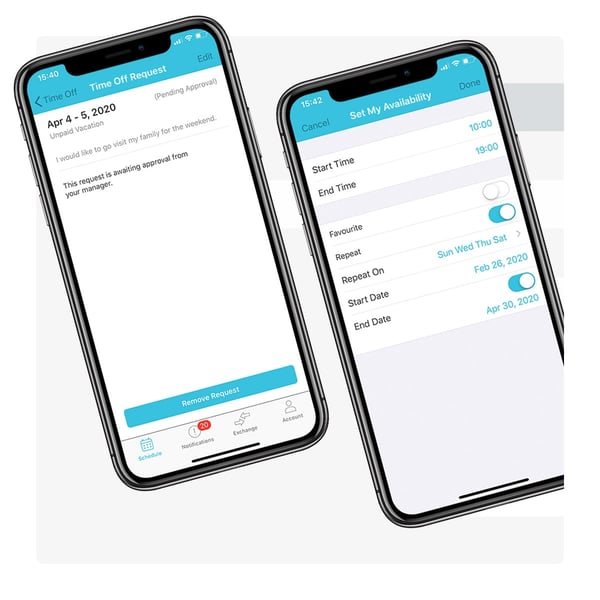
Shift swapping is a breeze.
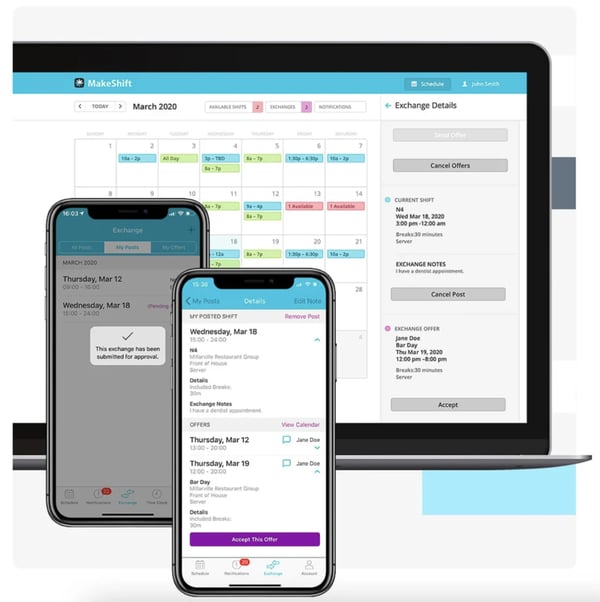
You can approve shift schedules and other requests on the go.

Utilize our new AI scheduling platform, ShiftMate AI, to simplify self-scheduling. — nurses can ask Smart Support for guidance when creating their schedule.
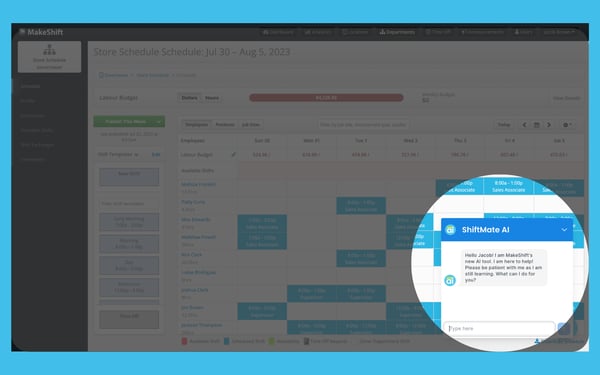
The Future of Nurse Scheduling
The future of nurse scheduling in the healthcare industry is marked by innovation, automation, and data-driven decision-making.
These advancements improve nurses’ work experience and enhance patient care quality, making it a win-win for healthcare organizations and their staff.
As tech continues to evolve, nurse scheduling will likely become even more efficient and tailored to the unique needs of the nursing profession.
Trends and Innovations in Nurse Scheduling
- Mobile scheduling apps — The nursing industry is increasingly adopting mobile scheduling apps that allow nurses to view, select, and modify their schedules on their smartphones. These apps offer convenience and real-time updates, making it easier for nurses to manage their work schedules.
- Shift bidding and auctions — Some healthcare facilities are exploring the concept of shift bidding and auctions, where nurses can bid on their preferred shifts. This approach gives nurses more control over their schedules while ensuring that shifts are distributed fairly based on preferences and seniority.
- AI-powered predictive scheduling — AI-driven predictive scheduling is becoming a hot trend. AI algorithms analyze historical data, patient admission trends, and nurse availability to generate optimized schedules that minimize understaffing and overstaffing.
The Role of Artificial Intelligence and Data Analytics
- Demand forecasting — AI and data analytics help predict patient admissions, surgeries, and emergency department visits. This data helps anticipate peak demand periods and adjust staffing levels accordingly, ensuring enough nurses are on hand to provide quality care.
- Smart scheduling algorithms — AI-driven algorithms consider nurse preferences, skill levels, and certifications when creating schedules. These algorithms optimize the allocation of shifts, leading to more balanced and efficient schedules that reduce nurse burnout.
- Real-time monitoring — AI and data analytics provide real-time monitoring of nurse workloads and patient-to-nurse ratios. This enables immediate adjustments when staffing needs change suddenly, ensuring patient safety.
FAQ
What is Nurse Self Scheduling?
Self-scheduling lets nurses choose their own shifts. Instead of shouldering all shift planning and schedule creation yourself, you give your nurses the option to pick shifts that best suit their personal needs.
What is the advantage of nurse self-scheduling?
Nurses feel more ownership and job satisfaction when they have more control over their schedules. Managers spend less time on schedule management.
Is self-scheduling better for nurses?
In most cases, yes, because they can have more work-life balance, preventing burnout and reducing work-related stress.
What is a nurse self-scheduling policy?
A nurse self-scheduling policy is a set of guidelines and rules established by a healthcare facility that supports a self-scheduling system. This policy aims to improve nurses' work-life balance, job satisfaction, and overall well-being by giving them more control over their schedules, ultimately benefiting both nurses and patients.
Why Wait to Implement Self-Scheduling for Your Nursing Staff?
A self-scheduling system takes streamlining scheduling to a new level. It’s efficient and boosts morale among your nursing staff because they’ll feel more in control of their work life.
Worried about the cost? Don’t be.
The initial investment in self-scheduling software is offset by long-term cost savings in administration and retention rates, making it a financially viable solution for your organization.
Ready to see for yourself? Schedule a free demo of MakeShift to see smarter scheduling in action.




